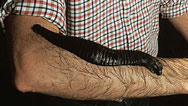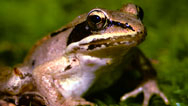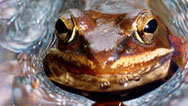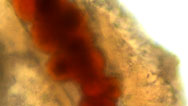Leeches
- Posted 07.23.08
- NOVA scienceNOW
(This program is no longer available for online streaming.) Leeches can consume seven or eight times their body weight in blood, says leech expert Mark Siddall. As doctors are now discovering, this talent, along with the bloodsuckers' natural anti-coagulant, can benefit patients who have had fingers or toes reattached. Find out how in this video segment.
Transcript
LEECHES
PBS Airdate: July 23, 2008
NEIL DeGRASSE TYSON: Hello, I'm Neil deGrasse Tyson, your host of NOVA scienceNOW. You know, in the old days, centuries ago, barbers were considered medical professionals. Instead of a shave and a haircut, for two bits, what you'd get was the cutting-edge treatment of the day, and that was bloodletting.
And sometimes they did it, not with razors, but with a tiny little helper.
Modern medicine is not generally into bloodletting, but, strangely enough, in some cases, surgeons have come to rely once again on this talented little creature.
Ladies and gentlemen, it turns out the leech is back!
So how....you just look for ponds wherever you find them and...
MARK SIDDALL: Well, they have to have a certain character.
NEIL DeGRASSE TYSON: I wasn't quite sure what to expect, when biologist Mark Siddall, my colleague from the American Museum of Natural History, led me through the woods into a muddy swamp.
MARK SIDDALL: It's not too bad.
NEIL DeGRASSE TYSON: But I suspected it might be just kind of gross.
This is nasty; let the record show. Are we getting sucked on right now?
MARK SIDDALL: Not likely to be being fed on just yet. Normally, it takes them a little while to realize we're here. They respond to movement in the water first.
NEIL DeGRASSE TYSON: Within a few minutes, hungry leeches tracked us down and were swimming right towards us.
MARK SIDDALL: There's one right there, right there, right there in the water.
NEIL DeGRASSE TYSON: Do I grab him?
MARK SIDDALL: Yup. It's a beautiful, beautiful macrobdella decora, literally, "decorated leech." They have orange polka dots that go down the back.
NEIL DeGRASSE TYSON: Unlike Mark, the squirmy thing's body decoration was the last thing on my mind.
MARK SIDDALL: He's not going to bite you.
NEIL DeGRASSE TYSON: He started to bite me!
MARK SIDDALL: He did not.
NEIL DeGRASSE TYSON: He was hanging on.
MARK SIDDALL: That was his back sucker, not his mouth sucker.
NEIL DeGRASSE TYSON: You can't blame me for getting a little squeamish. After all, aren't these the bloodsucking creatures that turn up in movies to terrorize anybody who wanders into fresh water?
HUMPHREY BOGART in AFRICAN QUEEN: If there's anything in the world I hate, it's leeches, filthy little devils!
NEIL DeGRASSE TYSON: Once upon a time, people often put leeches on their bodies on purpose. For centuries, people believed that intentional bleeding was good for you, as a way to regulate what were called the body's "humors."
MARK SIDDALL: If someone was sick, all you had to do was rebalance the humors. You have four humors: blood, yellow bile, black bile and phlegm. And what you needed to do was get the right balance of those, and then you would be fine.
NEIL DeGRASSE TYSON: In 19th century Europe, the leech became the method of choice for all-purpose bloodletting. Fever? Try a leech. Headache? Stick one on your temple. Overweight? Never fear, leeches to the rescue.
JOSEPH UPTON (Beth Israel Deaconess Medical Center): Leeching was kind of a panacea. If somebody had a black eye or a big shiner or something, they'd put a leech on it. That was commonplace.
NEIL DeGRASSE TYSON: Eventually, people began to realize for a lot of the patients, all this bloodletting wasn't really helping. And the leech fell into disrepute, the poster child of medical ignorance.
Of course, it wasn't really the leeches' fault. They were just doing what they're good at, dining on your blood.
MARK SIDDALL: Uh, oh.
NEIL DeGRASSE TYSON: He's got one.
MARK SIDDALL: Yup.
NEIL DeGRASSE TYSON: For some reason, the leeches here seemed to prefer Mark's legs to mine.
MARK SIDDALL: You got any on you, by the way?
NEIL DeGRASSE TYSON: I don't know. Will I feel it?
MARK SIDDALL: Yes, you will. You will feel a pinch.
NEIL DeGRASSE TYSON: And one really chowed down on the knee of Mark's assistant, Sara Watson.
MARK SIDDALL: So what the leech is doing right now is it's filling up with Sara's blood.
NEIL DeGRASSE TYSON: These leeches live exclusively on blood, and a huge stomach is key for their survival.
MARK SIDDALL: So leeches can feed six to seven, maybe eight times their unfed body weight in blood. And because of that, what they do is they hold onto that blood in the stomach, squeeze a little bit down into the intestines as they need it after they've finished feeding, and digest it while they're hiding under a rock or going off to find a mate.
NEIL DeGRASSE TYSON: A leech can live for months on one good blood meal, but a full stomach creates a potential risk. Left alone, the blood would soon clot and thicken. So the leech produces a powerful anti-coagulant, a blood thinner.
MARK SIDDALL: The importance of this is obvious, if you're a leech, because if you fill up with blood to, like, six or seven times your body weight, if that blood clots inside of you, you're going to turn into a brick and fall to the bottom of the water. You can't swim; you can't mate; you can't have young. You can't get away from predators, and it's all over. So, these anti-coagulants are extremely important in terms of the leeches' survival.
NEIL DeGRASSE TYSON: And this blood thinner, so crucial to the creature's survival, is one reason the leech's reputation has recently been rehabilitated.
Construction worker Thomas Clark had seen some leeches as a kid, but a few months ago, they played a major role in his life.
THOMAS CLARK: That particular day, I was doing tree work. So I was in a little Bobcat(R). It's pretty simple.
NEIL DeGRASSE TYSON: Clark was using a small loader to lift a tree trunk into a dump truck when things suddenly went wrong.
THOMAS CLARK: As I was rolling the log off, the Bobcat tilted forward, came off the rear wheels. My hand came out of the Bobcat, and this part of the Bobcat kissed the side of the dump truck and crushed off all these fingers. Exactly right here, chu, chu, chu, chu.
It just looked like I put my hand in a meat grinder 'cause it, like, it smushed.
NEIL DeGRASSE TYSON: Clark was rushed to the hospital where surgeons struggled to rebuild his hand.
AMIR TAGHINIA (Beth Israel Deaconess Medical Center): The middle finger had the worst injury, by far. It was really just hanging off by one tendon. And it was sort of twisted on itself. And we had to do quite a bit of surgery to get that finger to live.
NEIL DeGRASSE TYSON: The next day, Clark's middle finger was not doing well.
THOMAS CLARK: It was turning black, and they said that it was dying. So they were going to take it off.
NEIL DeGRASSE TYSON: Too much blood was coming into his finger, but not getting out. The veins that normally carry the blood away were too badly damaged.
AMIR TAGHINIA: If there's blood going into the finger, but there's no blood coming out of the finger, pressure builds up, and the tissues can't tolerate that. If you were to leave that state and not doing anything to relieve that pressure, relieve that tension, relieve that outflow, the finger would die.
NEIL DeGRASSE TYSON: It didn't look like more surgery would fix the problem. So, even though doctors usually want to stop bleeding after an operation, in this case, it was just the opposite.
AMIR TAGHINIA: So your next option is to use leeches.
THOMAS CLARK: I was actually kind of, like, "Cool." You know, I was like, you know, "Whatever works. I don't want to lose anything, you know. So, if it's going to work, let's do it."
NEIL DeGRASSE TYSON: Leeches were brought in to feed on his finger and suck out the extra blood.
THOMAS CLARK: Every time my heart beat, it was like the leech was sucking with the beat of my heart, and it was like a pump. It was like "bum-bum, bum-bum."
NEIL DeGRASSE TYSON: As the leech sucks, it releases that powerful blood thinner into the finger, which prevents clotting.
AMIR TAGHINIA: The leech is interesting. It injects a blood thinner, called herudin, into the soft tissues around that area. So when the leech gets full and falls off, the finger continues to bleed. That buys you time, that process.
NEIL DeGRASSE TYSON: With a few days of leeching, the finger can naturally grow new veins and resume healthy blood circulation.
THOMAS CLARK: It was almost instant. You could tell that it was working, because my...the swelling was going down. The open wounds were actually healing. And I could actually feel a pulse in my finger. And the blackness started going away. And, like, the part of my finger that was dying started coming back to life.
JOSEPH UPTON: When you're in a situation where you've already done everything that you can technically do, and then you're still having problems, actually, the leeches are very valuable. They're incredibly valuable.
NEIL DeGRASSE TYSON: Thomas Clark's leech therapy worked. Though he hasn't regained full function of his hand, his fingers were all saved.
THOMAS CLARK: I definitely wanted to keep my hand and all fingers, because the human body's got ten fingers, not nine. So it means a lot. It does. The leeches saved my finger, no doubt about it.
AMIR TAGHINIA: They're really indispensable for what we do. And there would be many a finger's lopped off if it weren't for leeches.
NEIL DeGRASSE TYSON: The leech's comeback delights biologist Mark Siddall, but his appreciation goes far beyond its medical usefulness.
I don't mind him crawling on me, as long as I know when he's about to bite.
Leeches are a kind of worm, and there are hundreds of different species living all over the world.
MARK SIDDALL: He's trying to find a place to feed on me.
There are terrestrial leeches, there are fresh water leeches, there are marine leeches. There's just this huge diversity of form, color, pattern and even of behavior.
And most of them are not very specific, in terms of what they'll feed on, but some of them are. Some of them are very specific to fish, and there's even one in Africa that lives exclusively in the rectum of hippopotamus.
NEIL DeGRASSE TYSON: Eww.
MARK SIDDALL: Yes, well, there was a paper written called, "Leeches Ride the Tunnel of Love," because they mate there.
NEIL DeGRASSE TYSON: You sure?
Leeches have been crawling and swimming around Earth for hundreds of millions of years. For Siddall, these graceful creatures are fascinating, even beautiful, despite their taste for blood.
MARK SIDDALL: Leeches are unnecessarily maligned. They don't take more blood than you can reproduce by yourself. And you know what? Unlike a mosquito or a black fly, they don't transmit any parasites. And quite frankly, if you took some time to have a look at them, you'd see just how pretty they are. I know most people don't really think about conserving leeches, but just like any group of organisms on the face of this planet, wouldn't it be just a little bit colder and darker without them?
Credits
Leeches
- Edited by
- Steve Audette & Harlan Reiniger
- Written, Produced and Directed by
- Julia Cort
NOVA scienceNOW
- Executive Producer
- Samuel Fine
- Executive Editor
- Neil deGrasse Tyson
- Senior Series Producer
- Vincent Liota
- Supervising Producers
- Stephen
Sweigart
Joey David - Editorial Producer
- Julia Cort
- Development Producer
- Vinita Mehta
- Senior Editor
- David Chmura
- Online Editor
- Laura Raimondo
- Series Production Assistant
- Fran Laks
- Assistant Editors
- Susan Perla
Tung-Jen (Sunny) Chiang - Compositors
- Brian Edgerton
Yunsik Noh - Music
- Rob Morsberger
- NOVA scienceNOW series animation
- Edgeworx
- Associate Producers
- Melanie
Cunningham
Heeth Grantham
Joan Johnson
Molly Longstreth
Anthony Manupelli
Corey Norman - Camera
- John Baynard
James Callanan
Brian Dowley
Mike Elwell
Tom Fahey
Sean Glenn - Sound Recordists
- Brad Berghom
Clint Bramesco
John Cameron
Tom Eichler
Bill Stefanacci
Dick Williams - Sound Mix
- David Chmura
- Animation
- Eyeball
Carlo Flores
Anthony Kraus, Noisy Neighbor Productions
Zaldy Serrano - Production Assistants
-
Jared Flynn
Elizabeth Stachow
Robin Wiesner - For Lone Wolf Documentary Group
- Executive Producer
- Kirk Wolfinger
- Production Manager
- Donna Huttemann
- For Public Broadcasting for Northern California, KQED
- Executive producer
- Sue Ellen McCann
- Business Manager
- Sandy Schonning
- Archival Material
- California High Speed Rail Authority
Corbis
Mary Evans / Photo Researchers, Inc.
Ship and submersible footage courtesy of Harbor Branch Oceanographic Institute
NASA / STScI
Newlands and Company, Inc.
Orion Treasury Project Team
Orwell Astronomical Society (OASI)
SETI Institute
University of Alabama at Birmingham Department of Pathology PEIR Digital Library
U.S. National Library of Medicine
Edie Widder
Nikica Zaninovic, Richard Bodine, Roger Gosden, Zev Rosenwaks, Lucinda Veeck Gosden at the Center for Reproductive Medicine and Infertility
Embryology Laboratory, Weill Cornell Medical College, New York. - Special Thanks
-
American Museum of Natural History
Beth Israel Deaconess Medical Center
Harbor Branch Oceanographic Institute
Christy Herren
Tom Kilsdonk, SETI Institute
Kevin Langton
John Lewis
Larry Madin
Illustrator Janeen Mason
Michael Nank
Chris Neller, SETI Institute
The ORCA Team
Karen Randall, SETI Institute
Brad Seibel
Yankee - Neil deGrasse Tyson
- is director of the Hayden Planetarium in the Rose Center for Earth and Space at the American Museum of Natural History.
- NOVA scienceNOW Consortium Stations
- Nebraska
Educational Telecommunications, NET
Public Broadcasting for Northern California, KQED
Twin Cities Public Television, TPT
Wisconsin Public Television, WPT - NOVA Series Graphics
- yU + co.
- NOVA Theme Music
- Walter Werzowa
John Luker
Musikvergnuegen, Inc. - Additional NOVA Theme Music
- Ray Loring
Rob Morsberger - Post Production Online Editor
- Spencer Gentry
- Closed Captioning
- The Caption Center
- Publicity
- Carole McFall
Eileen Campion
Lindsay de la Rigaudiere
Victoria Louie
Kate Becker - Senior researcher
- Gaia Remerowski
- Production Coordinator
- Linda Callahan
- Paralegals
-
Raphael Nemes
Sarah Erlandson - Talent Relations
- Scott Kardel, Esq.
Janice Flood - Legal Counsel
- Susan Rosen
- Post Production Assistant
- Darcy Forlenza
- Associate Producer, Post Production
- Patrick Carey
- Post Production Supervisor
- Regina O'Toole
- Post Production Editors
-
Rebecca Nieto
Alex Kreuter - Post Production Manager
- Nathan Gunner
- Compliance Manager
- Linzy Emery
- Development Producer
- Pamela Rosenstein
- Business Manager
- Joseph P. Tracy
- Senior Producer and Project Director
- Lisa Mirowitz
- Coordinating Producer
- Laurie Cahalane
- Senior Science Editor
- Evan Hadingham
- Senior Series Producer
- Melanie Wallace
- Managing Director
- Alan Ritsko
- Senior Executive Producer
- Paula S. Apsell
This material is based upon work supported by the National Science Foundation under Grant No. 0638931. Any opinions, findings, and conclusions or recommendations expressed in this material are those of the author(s) and do not necessarily reflect the views of the National Science Foundation
NOVA scienceNOW is a trademark of the WGBH Educational Foundation
NOVA scienceNOW is produced for WGBH/Boston by NOVA
© 2008 WGBH Educational Foundation
All rights reserved
- Image credit: (leeches in jar) Photo by Julia Cort, © WGBH Educational Foundation
Participants
- Thomas Clark
- Accident Victim
- Neil deGrasse Tyson
- Astrophysicist, American Museum of Natural History
- Mark Siddall
- American Museum of Natural History research.amnh.org/~siddall/
- Amir Taghinia
- Beth Israel Deaconess Medical Center
- Joseph Upton
- Beth Israel Deaconess Medical Center
Related Links
-

Leeches: Expert Q&A
Mark Siddall, lord of leeches at the American Museum, answers questions about these stretchy, bloodsucking creatures.
-

Hunt for the Giant Leech
You suddenly find yourself waist-deep in the swampy home of the giant Amazonian leech. What now?
-

Frozen Frogs
The common wood frog freezes solid every winter and then, come spring, defrosts and mates.
-

Cold Cures
The inner workings of frozen frogs offer insight into the medical uses of extreme cold.
-

T. Rex Blood?
Preserved soft tissue, including possible blood vessels and red blood cells, are turning up in dinosaur fossils.



